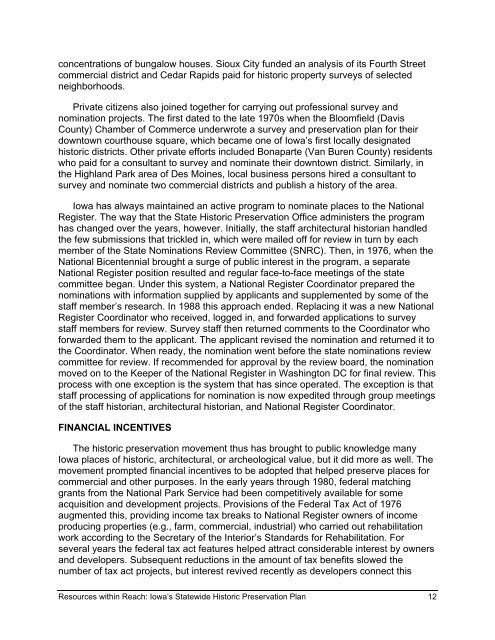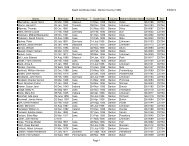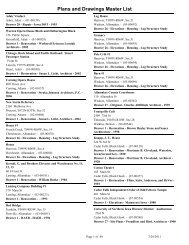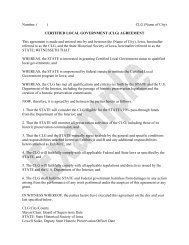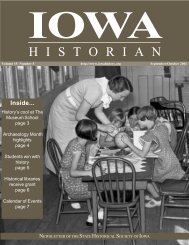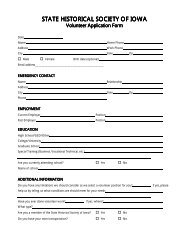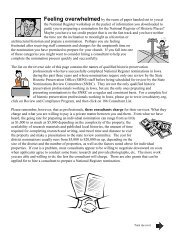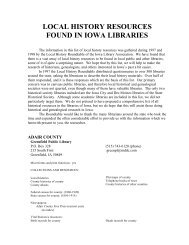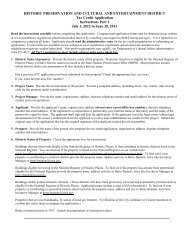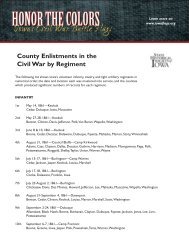Resources within Reach - State Historical Society of Iowa
Resources within Reach - State Historical Society of Iowa
Resources within Reach - State Historical Society of Iowa
- No tags were found...
You also want an ePaper? Increase the reach of your titles
YUMPU automatically turns print PDFs into web optimized ePapers that Google loves.
concentrations <strong>of</strong> bungalow houses. Sioux City funded an analysis <strong>of</strong> its Fourth Streetcommercial district and Cedar Rapids paid for historic property surveys <strong>of</strong> selectedneighborhoods.Private citizens also joined together for carrying out pr<strong>of</strong>essional survey andnomination projects. The first dated to the late 1970s when the Bloomfield (DavisCounty) Chamber <strong>of</strong> Commerce underwrote a survey and preservation plan for theirdowntown courthouse square, which became one <strong>of</strong> <strong>Iowa</strong>’s first locally designatedhistoric districts. Other private efforts included Bonaparte (Van Buren County) residentswho paid for a consultant to survey and nominate their downtown district. Similarly, inthe Highland Park area <strong>of</strong> Des Moines, local business persons hired a consultant tosurvey and nominate two commercial districts and publish a history <strong>of</strong> the area.<strong>Iowa</strong> has always maintained an active program to nominate places to the NationalRegister. The way that the <strong>State</strong> Historic Preservation Office administers the programhas changed over the years, however. Initially, the staff architectural historian handledthe few submissions that trickled in, which were mailed <strong>of</strong>f for review in turn by eachmember <strong>of</strong> the <strong>State</strong> Nominations Review Committee (SNRC). Then, in 1976, when theNational Bicentennial brought a surge <strong>of</strong> public interest in the program, a separateNational Register position resulted and regular face-to-face meetings <strong>of</strong> the statecommittee began. Under this system, a National Register Coordinator prepared thenominations with information supplied by applicants and supplemented by some <strong>of</strong> thestaff member’s research. In 1988 this approach ended. Replacing it was a new NationalRegister Coordinator who received, logged in, and forwarded applications to surveystaff members for review. Survey staff then returned comments to the Coordinator wh<strong>of</strong>orwarded them to the applicant. The applicant revised the nomination and returned it tothe Coordinator. When ready, the nomination went before the state nominations reviewcommittee for review. If recommended for approval by the review board, the nominationmoved on to the Keeper <strong>of</strong> the National Register in Washington DC for final review. Thisprocess with one exception is the system that has since operated. The exception is thatstaff processing <strong>of</strong> applications for nomination is now expedited through group meetings<strong>of</strong> the staff historian, architectural historian, and National Register Coordinator.FINANCIAL INCENTIVESThe historic preservation movement thus has brought to public knowledge many<strong>Iowa</strong> places <strong>of</strong> historic, architectural, or archeological value, but it did more as well. Themovement prompted financial incentives to be adopted that helped preserve places forcommercial and other purposes. In the early years through 1980, federal matchinggrants from the National Park Service had been competitively available for someacquisition and development projects. Provisions <strong>of</strong> the Federal Tax Act <strong>of</strong> 1976augmented this, providing income tax breaks to National Register owners <strong>of</strong> incomeproducing properties (e.g., farm, commercial, industrial) who carried out rehabilitationwork according to the Secretary <strong>of</strong> the Interior’s Standards for Rehabilitation. Forseveral years the federal tax act features helped attract considerable interest by ownersand developers. Subsequent reductions in the amount <strong>of</strong> tax benefits slowed thenumber <strong>of</strong> tax act projects, but interest revived recently as developers connect this<strong>Resources</strong> <strong>within</strong> <strong>Reach</strong>: <strong>Iowa</strong>’s <strong>State</strong>wide Historic Preservation Plan 12


